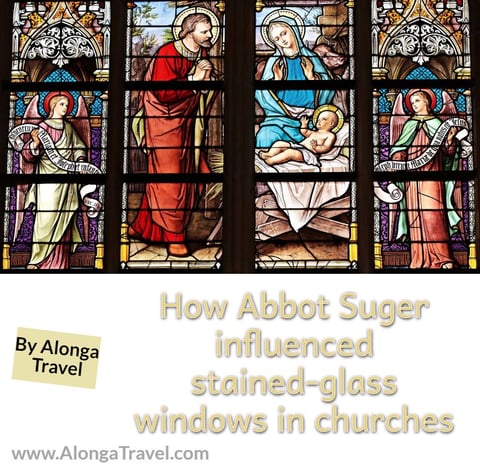Influence of Theology on Architecture: the Relationship between Religion and Design
Religion and theology have shaped the history of architecture, and church architecture in particular, in various ways. It inspired the design, symbolism, function, and ornamentation of religious buildings across different cultures and periods.
Theologians’ interpretations of sacred texts and theological principles have been translated into tangible architectural elements that we still see today. It helped with creating spaces that not only brough people to worship but also embody the beliefs and values of the faith through sacred architecture.
This influence is particularly evident in the evolution of architectural styles such as Gothic, where theological concepts influenced the design and implementation.
Hi, I’m Tatiana. I show my experience from my daily walks in new cities/countries/areas (I’m a nomad), where I look for places with fun architecture, beautiful old buildings, lovely vibe & pretty scenes. I find the best destinations to visit in Europe and beyond & I record everything.
Who are the theologians
Theologians are scholars who specialize in the systematic and rational study of concepts of God and the influences they have, as well as the nature of religious truths. Through various methodologies, theologians analyze and interpret religious experiences, texts, and practices. Theologians come from various religious backgrounds and they explore a wide range of subjects in their studies.
For example, they study sacred texts to gain a deeper understanding for such profound questions as the existence and qualities of God. They also ponder ethical matters, and examine the relationship between religion and science.
Most famous theologians
Some notable theologians include:
- Apostle Paul of Tarsus (died c. 60–65)
- Papias of Hierapolis (c. 60 – c. 130)
- Apostle James, Son of Zebedee
- Apostle Simon Peter
- Apostle John, Son of Zebedee
- Ignatius of Antioch (c. 35 or 50 – between 98 and 117)
- Polycarp (c. 69 – c. 155)
- Clement of Rome (fl. c. 96)
- Justin Martyr (c. 110 – c. 165)
- Irenaeus of Lyons (died c. 202)
- Tertullian (c. 160 – c. 220)
- Origen (c. 184 – c. 253)
- Augustine (354–430)
- Thomas Aquinas (1224 to 1274)
These people have made important contributions to different doctrines and the way we understand religion.

Architecture and Theology: the tangible changes to buildings
Religion and theology have played a big role in shaping architect history. This influence can be seen in different ways, like how religious buildings are designed, the symbols they use, what they are used for, and how they are decorated.
Take the story of the Sacred City as an example.
The Bible story of a Sacred City
The heavenly city symbolizes the ultimate destination for people of faith and is described as a perfect and peaceful place where God is present.
The Bible contains passages that demonstrate God’s interest in and involvement with human construction, including the detailed instructions for building the tabernacle and the temple.
In the Book of Revelation, Saint John is taken on a tour of the heavenly city by an angel who provides specific details about its size, gates, and materials.
Even though the heavenly city is not a physical location, its description has influenced the design and symbolism of religious buildings. The relationship between the heavenly city, theology, and architecture is deeply rooted in religious symbolism and beliefs.
Architects and theologians have used these descriptions to create spaces that reflect the divine and offer a glimpse of what the heavenly city might be like.
This can be observed in the design of churches and cathedrals, where elements such as height, light, and the arrangement of space are utilized to symbolize the transcendence of God and the heavenly realm.
The concept of the heavenly city has had a significant impact on the design and symbolism of religious architecture. It provides a theological basis for the creation of spaces that connect with the divine.
So, basically, the real tangible architecture was created as a result of interpretation of sacred texts.
Buildings Design and Religious architecture
Religious buildings are often designed to represent important symbols in a religion. For example, Christian churches might be laid out in the shape of a cross, which is a big symbol in Christianity and Christian community.
Islamic mosques often have a special niche in the wall called a mihrab that shows the direction of Mecca.

Symbolism in architecture
Symbols are important in religious architecture because they can tell important stories and represent deep ideas.
Hindu temples, for instance, often have intricate carvings and sculptures that show different gods and scenes from holy texts.
Arabic architecture and it’s kick off – Mudejar architecture have many symbols and religious inscription incorporated in Arabic and Mudejar buildings over the walls, ceilings and doorframes.
The best examples of Mudejar architecture would be Alhambra in Granada, Spain and The Roal Alcazar of Seville.
Buildings’ functions
Religious buildings are designed to serve a specific purpose that relates to the rituals and practices of a faith. Cloisters, for example, were built for the clergy to have a space to walk around, protected from the rain, and contemplate on life.
Buddhist temples often have a special area called a stupa where people can meditate and pray.
Buildings Ornamentation
The way religious buildings are decorated can have both symbolic and artistic meaning. It often reflects the artistic traditions of the culture and time period. For example, Gothic cathedrals are famous for their beautiful stained-glass windows that show stories from the Bible.
So, religion and theology have not only influenced the physical structures of religious buildings, but also the way people experience them spiritually.


Ecclesiastical architecture
Development of ecclesiastical architecture is the best example of how architecture was changing, based on the current dominant religion.
Ecclesiastical architecture refers to the design of buildings used for Christian worship. It has changed over the past two thousand years, combining new ideas and borrowing from other architectural styles, while also adapting to different beliefs, practices, and local traditions.
The earliest churches were based on the plan of the Roman basilica, a type of hall where justice was served. These churches typically had a central hall called a nave, with a flat timber roof to accommodate the gathering of the congregation.
As time went on, church architecture evolved to reflect changes in Christian theology, worship practices, and social contexts.
This led to the development of various architectural styles, such as Early Christian, Byzantine, Romanesque, Gothic, Renaissance, Baroque, Rococo, Neoclassical, and Revival styles in later centuries, and eventually the Modern style we see today.
Each church building carries clues in its design that reveal not only its architectural style, but also details about its designer, intended congregation, and purpose.
Church architecture is captivating for both believers and architecture admirers.

Examples of Theologians influence on architecture
Theologians had a profound influence on European architecture, especially on the religious buildings.
Abbot Suger
For example – Abbot Suger, who lived in France, had a big impact on Gothic architecture. He believed that light was sacred and could help people connect with God. This belief influenced the design of Gothic cathedrals, making them taller and more beautiful, with big stained-glass windows that let in lots of light.
This was confirmed by the recent study Harrison Undergraduate Research Grant recipient Martina Bucheli, a fourth-year University of Virginia architecture student majoring in architecture and art history. She examined the 12th-century renovation of the French abbey church of Saint-Denis, conducted under the direction of the Benedictine Abbot Suger. She came to the conclusion that Abbot Suger has, indeed, is responsible for Gothic architecture becoming so popular.
Furthermore, in the 12th century, a text called Dionysius became known and important to the clergy. This text, along with a type of theology called Neo-Platonism, made light even more important in Gothic architecture and church building.
The Gothic style is seen as a very organized and formal way to build churches, like a physical home for God on Earth. The unique elements of Gothic architecture: pointed arches and ribbed vaults, not only looked interesting, but also symbolized the goals and beliefs of the Christian church during medieval times.
Theologists not only influenced classic church architecture, but also Byzantine architecture.
If it weren’t for the influence of theologians on old architecture in Europe (and everywhere else), many of the old European buildings wouldn’t look the way they do.
Another example of theology on architecture is Architecture of Repentance
Architecture of Repentance
The idea of an architecture of repentance can be seen in how religious structures are built as a way to make up for past mistakes.
One example is the Jetavanaramaya Stupa in Anuradhapura, Sri Lanka. It was constructed by King Mahasena as a way to apologize for his role in the destruction of Mahavihara, a Buddhist monastery.
Building this impressive structure was his way of expressing genuine remorse and seeking purification. It shows us how architecture can be used as a form of repentance, creating sacred places that bring benefits to many people.
Modern church architecture is influenced by theologians to a lesser degree. At the same time the new modern community centers are reflection of the changes in theology and of the more pragmatic ways of the modern architecture of worships.
To learn more about Theology and architecture you can read the book “Christian Theology” or watch video courses by Murray Rae is a professor in the Theology Programme at the University of Otago
I hope you found my post informative. I am a big admirer of church architecture, and I like to learn about things I see. If you are anything like I, let’s connect on social media: the links are below. Send me a comment on Twitter ( I am the most active there).

Let’s connect on social media!
Found this post helpful? Please, consider supporting my work and the website maintenance cost, thank you!
Subscribe to my periodic newsletter for my new posts. New here? Visit my main Alonga Travel page.

